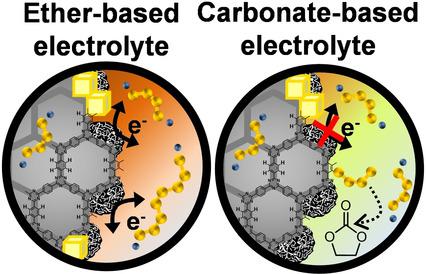当前位置:
X-MOL 学术
›
Batteries Supercaps
›
论文详情
Our official English website, www.x-mol.net, welcomes your
feedback! (Note: you will need to create a separate account there.)
Mechanistic Insights into the Role of Covalent Triazine Frameworks as Cathodes in Lithium‐Sulfur Batteries
Batteries & Supercaps ( IF 5.1 ) Pub Date : 2020-04-29 , DOI: 10.1002/batt.202000063 Erik Troschke 1 , Christian Kensy 1, 2 , Frederik Haase 3 , Susanne Dörfler 2 , Yvonne Joseph 4 , Bettina V. Lotsch 3 , Stefan Kaskel 1, 2
Batteries & Supercaps ( IF 5.1 ) Pub Date : 2020-04-29 , DOI: 10.1002/batt.202000063 Erik Troschke 1 , Christian Kensy 1, 2 , Frederik Haase 3 , Susanne Dörfler 2 , Yvonne Joseph 4 , Bettina V. Lotsch 3 , Stefan Kaskel 1, 2
Affiliation

|
This study illuminates the applicability of covalent triazine frameworks (CTFs) as a potential cathode material in lithium‐sulfur (Li−S) batteries. A systematic synthesis protocol is applied to generate a set of model CTFs containing covalently bound sulfur with varying porosities and conductivities. An in‐depth structural characterization reconsiders the bonding motif of sulfur within the pore system. The model materials are electrochemically evaluated in coin cells. The CTF cathodes exhibit practically no cycling performance as a result of active material loss in carbonate‐based electrolyte (≥200 mAh gsulfur−1 after 200 cycles). Moreover, in ether‐based electrolytes the differentiation between sulfur transformation on the surface of the conductive additive and the (semi‐)conducting CTF matrix is hardly feasible. Based on these results, the influence of the CTF material and the conductive additive with respect to sulfur utilization are discussed, demonstrating the critical role of this class of materials for application in Li−S batteries.
中文翻译:

机械研究共价三嗪框架作为锂硫电池中阴极的作用
这项研究阐明了共价三嗪骨架(CTF)作为锂硫(Li-S)电池中潜在的阴极材料的适用性。应用系统的合成方案来生成一组模型CTF,其中包含具有不同孔隙率和电导率的共价结合硫。深入的结构表征重新考虑了硫在孔隙系统中的键合基序。在纽扣电池中对模型材料进行电化学评估。由于活性炭在碳酸盐电解液中的损耗(≥200 mAh g硫-1),因此CTF阴极几乎没有循环性能200个周期后)。此外,在基于醚的电解质中,很难区分导电添加剂表面的硫转化和(半)导电CTF基质。基于这些结果,讨论了CTF材料和导电添加剂对硫利用的影响,证明了这类材料在Li-S电池中的关键作用。
更新日期:2020-04-29
中文翻译:

机械研究共价三嗪框架作为锂硫电池中阴极的作用
这项研究阐明了共价三嗪骨架(CTF)作为锂硫(Li-S)电池中潜在的阴极材料的适用性。应用系统的合成方案来生成一组模型CTF,其中包含具有不同孔隙率和电导率的共价结合硫。深入的结构表征重新考虑了硫在孔隙系统中的键合基序。在纽扣电池中对模型材料进行电化学评估。由于活性炭在碳酸盐电解液中的损耗(≥200 mAh g硫-1),因此CTF阴极几乎没有循环性能200个周期后)。此外,在基于醚的电解质中,很难区分导电添加剂表面的硫转化和(半)导电CTF基质。基于这些结果,讨论了CTF材料和导电添加剂对硫利用的影响,证明了这类材料在Li-S电池中的关键作用。











































 京公网安备 11010802027423号
京公网安备 11010802027423号